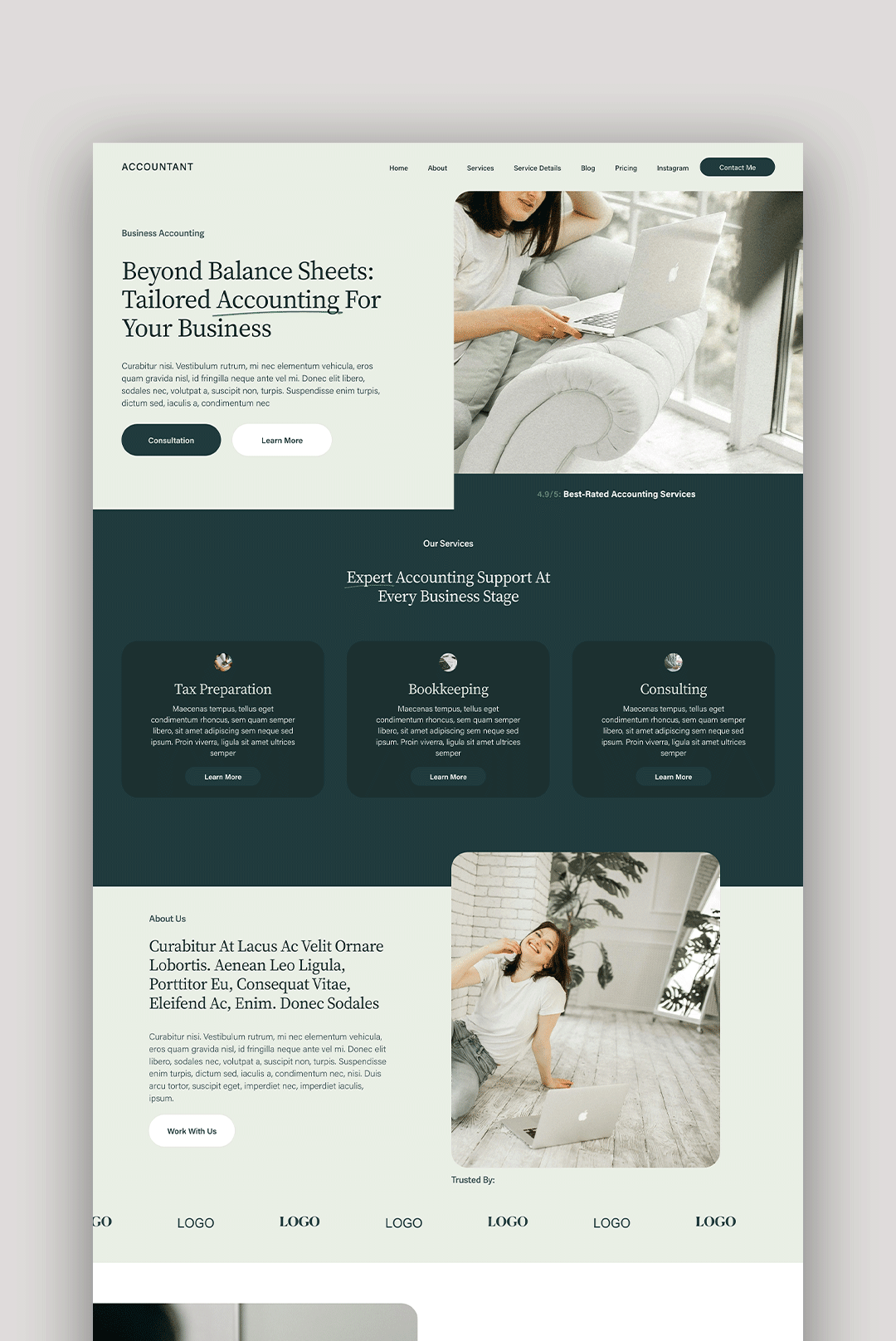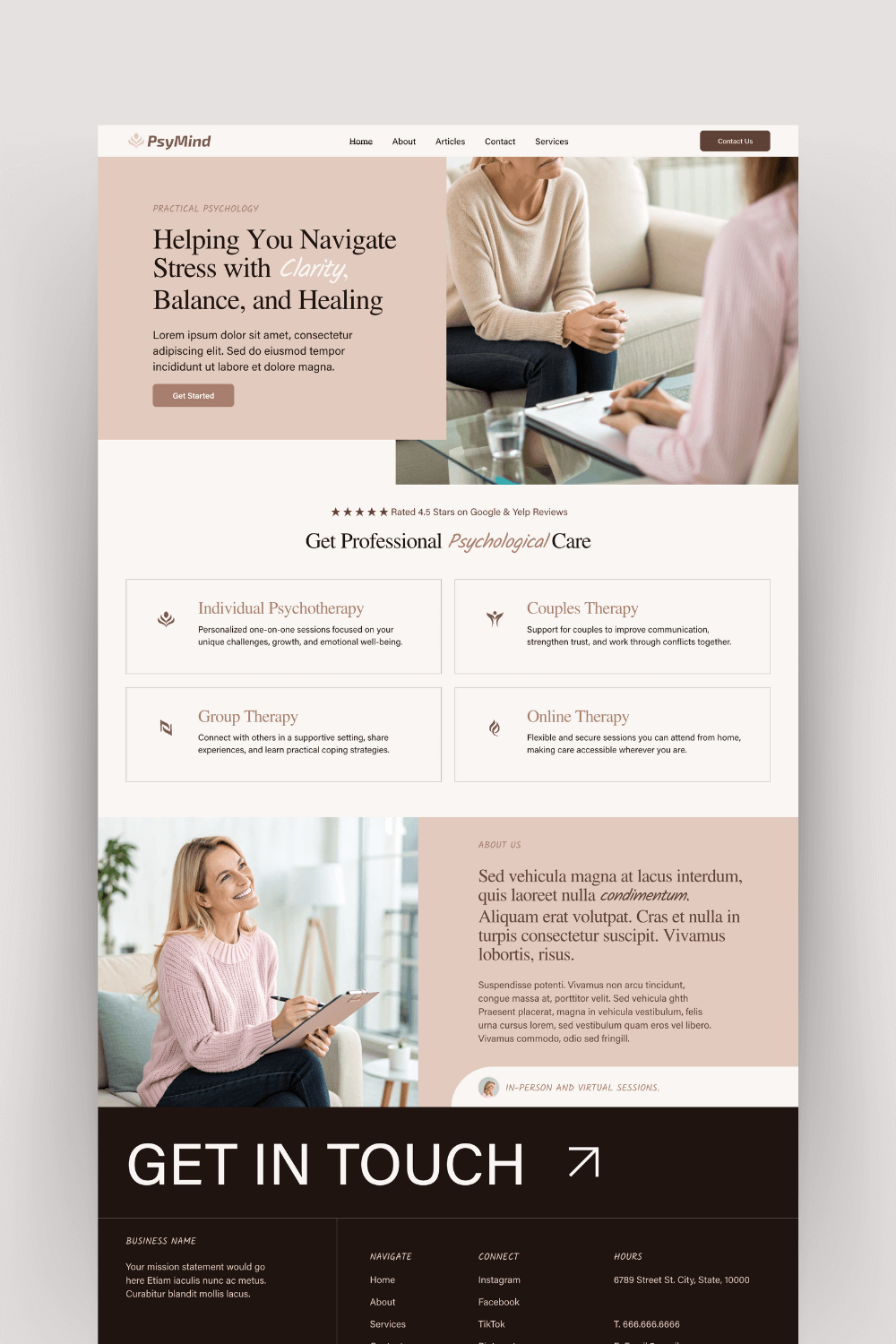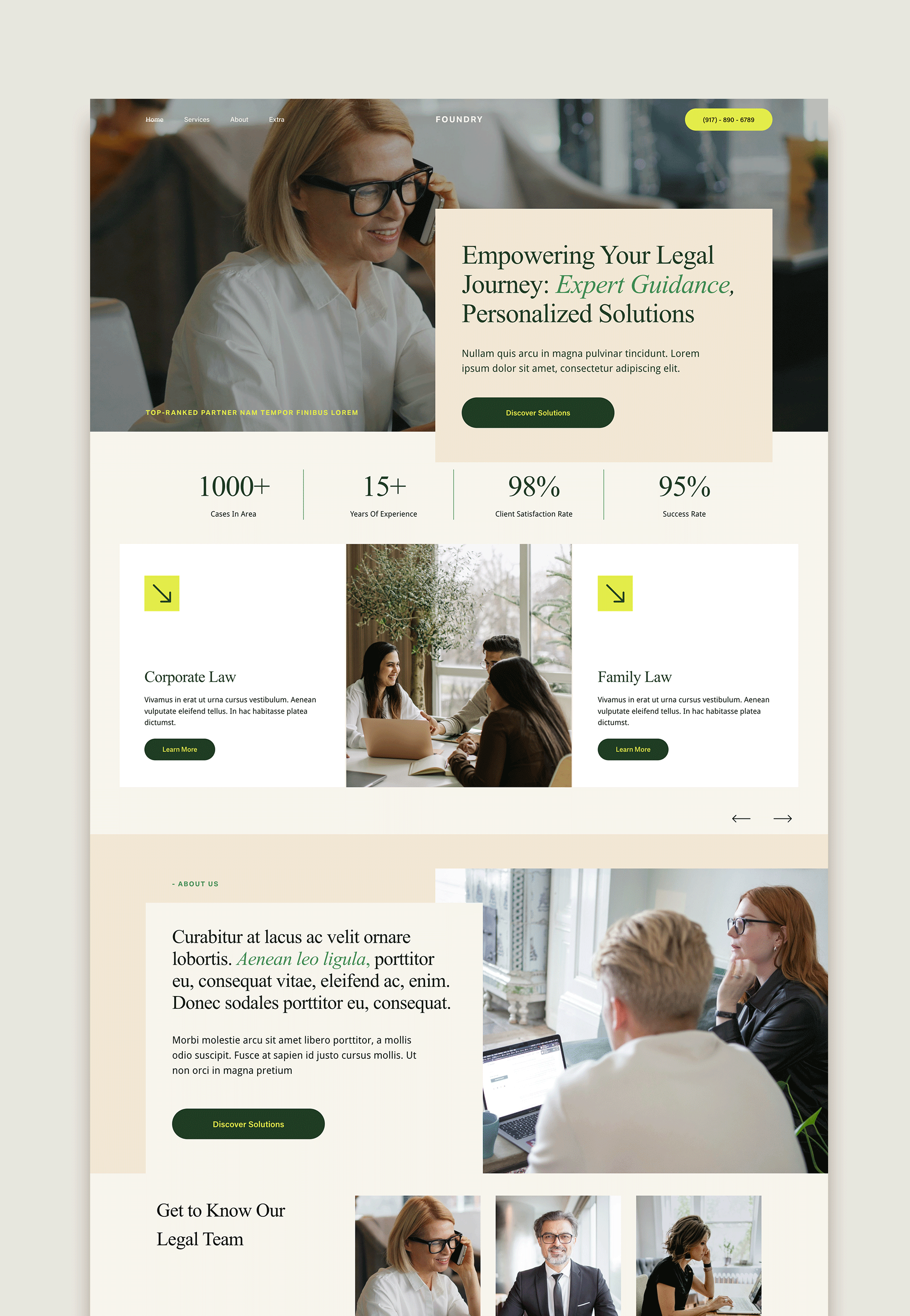How to Build a Therapists Website on Squarespace (Step-by-Step Guide 2025)
Let’s not sugarcoat it: if you’re a therapist, counselor, or holistic healer, your potential clients are Googling you. In 2025, having a well-designed, easy-to-navigate website is not just “nice to have”—it’s your front door. Before they ever sit on your couch or schedule that first Zoom session, they’re checking to see if you feel like the right fit. But here's the good news: you don’t need to hire a team of developers or wrestle with clunky tech to get a beautiful, fully functional therapy website online. Squarespace makes it possible—even if tech stresses you out more than a stack of unpaid CEU reminders.
Is Squarespace a Good Platform for Therapists?
Short answer? Yes. Longer answer: Squarespace continues to be a favorite among therapists, counselors, and psychotherapists for a reason. It’s clean. It’s intuitive. It looks professional right out of the gate. And with updates in 2025—including stronger SEO controls, even better templates, and AI-powered design suggestions—it's easier than ever to create a site that reflects your practice and values. Still unsure? Check out this full comparison we did on the best website builder for therapists to see why Squarespace stands out.
Before You Start: Define Your Website Goals
A therapy website isn’t just a digital brochure—it’s a tool. So before you start dragging and dropping anything, ask yourself:
What do I want visitors to do on my site? (Book? Read? Refer?)
Am I marketing a private practice, group practice, or specialized therapy services?
Who is my ideal client?
Do I need features like blogging, appointment scheduling, or secure contact forms?
Answering these questions will guide everything from your layout to your content. Whether you're a mental health therapist launching solo or a counselor expanding your practice, your website should support your growth—not just “exist.”
Step 1: Choose the Right Template for Therapists
Let’s talk design. Squarespace templates aren’t just pretty - they’re strategic. Some are built specifically with therapists in mind, offering calm color palettes, intuitive navigation, and built-in appointment booking features.
Some of the most popular options in 2025 include:
Wellness – Gentle and serene design with smooth navigation and built-in scheduling features.
Vitality – Bright, structured layout perfect for showcasing services, sharing updates, and blogging.
Balance – Modern, airy template designed for holistic therapists and wellness-focused practices.
Therapist – Sleek and minimalist with pre-built pages that cover all the essentials.
Looking for real-world examples? Browse this curated roundup of Squarespace website examples for therapists to get inspired.
Step 2: Set Up Your Squarespace Account
If you’ve never used Squarespace before, take a deep breath—this part is easy.
Head to Squarespace.com.
Start a free trial and choose your template (you can always change it later).
Don’t upgrade to a paid plan just yet—use the trial period to explore the platform and test layout options.
Choose the “Professional Services” category to see relevant layouts for therapy, coaching, and wellness.
Pro Tip: If you're working with a premium template (like one from Kseniia Design Studio), you’ll either get a contributor invite or a fresh copy of the design added to your account. This saves you time and preserves the layout integrity.
Step 3: Build a Homepage That Connects (Not Just Looks Pretty)
Your homepage is the handshake. It should introduce your practice, ease anxiety, and make it simple to take the next step.
Here’s a rough layout that works well for most mental health professionals:
Intro headline: Something clear and welcoming. Think: “Compassionate Therapy for Anxiety, Burnout, and Life Transitions.”
Short bio/about blurb: A few sentences that explain who you are and who you help.
Call-to-action (CTA): A button to book a consultation, view services, or read more about your approach.
Services overview: Highlight your top 2–3 offers with a link to the full services page.
Testimonials: (If you have client permission or use anonymized feedback.)
Contact/booking prompt: Make it easy to take the next step.
Still building confidence with layout? This step-by-step website guide breaks down the entire setup.
Step 4: Create a Services Page That Speaks to Your Clients
Too many therapists overcomplicate this section. You don’t need to list every modality or throw around clinical jargon. Focus on:
What problems you help with (e.g., trauma, anxiety, postpartum struggles)
Who you work with (e.g., teens, couples, adults, LGBTQ+ clients)
What your approach is like (gentle, structured, creative, trauma-informed)
Make each service its own section or block. Use anchor links at the top so clients can easily jump to what they need. If you’re a holistic therapist or counselor blending modalities, mention that clearly. A little personality goes a long way here.
Step 5: Add Booking or Contact Options
This might sound obvious, but so many therapy websites make it hard to book. You don’t want potential clients leaving because they couldn’t figure out how to reach you.
Options that work well:
Contact Form – For general inquiries or initial consultations.
Acuity or Calendly Integration – For online booking that syncs with your calendar.
Email CTA – If you prefer handling booking via email, make sure it’s clickable.
Phone Option – If you offer free consultations or prefer phone calls.
Whichever method you choose, include it on your homepage, services page, and in the site header or footer for quick access.
Step 6: Don’t Skip the About Page, Make It Relatable
Your About page isn’t your resume. It’s a chance to build trust. Readers are wondering:
Who is this person?
Will I feel safe with them?
Do they understand what I’m going through?
Write like you’re having a coffee chat, not defending your dissertation. You can mention your credentials - but lead with your “why.” Why do you do this work? What kind of therapy experience do you aim to create?
Bonus: Include a photo of yourself. People want to see who they’re talking to.
Step 7: Create a Blog to Support SEO
You don’t need to become a full-time blogger. But if you want to rank higher on Google—and help potential clients feel seen before they ever reach out—a blog can be powerful.
Here’s how to keep it simple and strategic:
Write what your clients are Googling. Think: “How to Manage Anxiety at Work” or “Signs of Burnout in New Moms.”
Use plain language. Your goal isn’t to sound like a research paper—it’s to connect.
Add a call-to-action (CTA). End every blog with something like “Want support with this? Contact me.”
Want more help? Check out this guide to Squarespace SEO for therapists—it breaks down exactly how to optimize your blog posts (without spending hours keyword-stuffing).
Step 8: Build a Calming Brand Experience
Therapy websites need to feel safe, grounded, and human—not overly slick or clinical. When thinking through your visual branding, prioritize:
Color palette: Soft blues, greens, or neutrals are calming and timeless.
Fonts: Keep them readable. One serif (for personality) + one clean sans-serif works great.
Photos: Choose images that reflect your tone. Avoid generic stock photos of sad people staring out windows.
Your goal isn’t to impress—it’s to build trust. A cohesive brand lets visitors know you’re thoughtful, professional, and approachable.
Step 9: Set Up Mobile Responsiveness
Here's a not-so-fun fact: over 60% of therapy website visits in 2025 happen on a phone. And if your mobile version is clunky or hard to navigate? You're losing clients before they ever scroll. Luckily, Squarespace 7.1 templates are fully responsive by default—but it’s still smart to:
Test every page on mobile
Reduce text blocks (long paragraphs are harder to read on phones)
Make buttons full-width
Keep forms short
Want to double-check your layout? Just toggle to mobile view in the site editor, or preview your site on your phone as you build.
Step 10: Make It Legal: Disclaimers, Privacy, and HIPAA Notes
This is where a lot of therapists panic. But it doesn’t have to be overwhelming. You’re likely not collecting health data directly through your site (unless you have custom forms)—but you should still cover your bases:
Privacy Policy: Required if you’re collecting emails or running analytics. Squarespace has boilerplate versions you can customize.
Disclaimer: Make it clear your website content is for informational purposes and not a substitute for therapy.
Terms & Conditions: Especially if you offer digital resources or online scheduling.
HIPAA note: If you’re accepting forms with sensitive info, make sure the platform or plugin is HIPAA-compliant—or stick to secure email or scheduling platforms that handle that externally.
Pro tip: If in doubt, consult a lawyer familiar with therapy practices—or use a legal template written specifically for mental health websites.
Step 11: Link Your Socials (But Keep It Professional)
Many mental health professionals wonder: “Do I have to link Instagram or Facebook?”
Short answer: no. But if you do have a public-facing social presence (like educational posts or practice updates), linking it can be helpful for:
Building trust and familiarity
Showing your tone and values
Sharing timely updates
Just remember:
Don’t mix personal and professional content
Use a business handle
Double-check HIPAA compliance (no client info in comments or captions!)
Step 12: Create a Clear Navigation Menu
Navigation is your website’s GPS. Keep it simple and intuitive. Avoid 10-page menus or dropdown chaos. Here’s a structure that works beautifully for most therapy websites:
Home
About
Services
Contact
(Optional) Blog
(Optional) FAQs
(Optional) Resources or Client Portal
Put the most important pages first—especially those that help a visitor take action.
Step 13: Add Testimonials or “What to Expect” Sections
We know—therapists can’t ask clients for Google reviews or testimonials the way a hair stylist can. But there are ways to build credibility ethically.
Options include:
Anonymous client feedback, with permission
“What to Expect” statements, to reduce first-time anxiety
Colleague endorsements (e.g., supervision praise, if applicable)
Practice values section (talk about your tone, space, accessibility, etc.)
Adding one of these to your homepage or services page can reassure potential clients that you’re the right fit.
Step 14: Set Up Email or Newsletter
You don’t need a full email funnel, but it’s smart to start collecting emails in case you:
Want to launch a workshop
Share a free resource (like a journaling guide)
Send monthly updates
Squarespace has built-in forms you can connect to Mailchimp or Squarespace Email Campaigns.Example opt-in:
“Get monthly tips for managing anxiety, setting boundaries, and protecting your peace.”
Again: keep it light. You’re a therapist, not a marketer in a turtleneck.
Step 15: Preview, Test, and Publish
You’re almost there. Before going live:
Click every link
Test forms and booking buttons
Review on both desktop and mobile
Ask a friend or colleague to give feedback
Once it all looks good, hit “Publish.” And just like that, you’ve got a living, breathing therapist website - built on Squarespace and totally aligned with your brand.
Want a Shortcut?
If the thought of pulling this all together makes your eye twitch, don’t worry. You can always skip the tech headache and hire me to build your Squarespace website- in as little as 5 days, you’ll have a polished, peaceful, client-ready site that reflects your practice.
Step 16: Use a Premium Template to Save Time (and Stress)
Let’s be honest—starting with a blank Squarespace template can feel like staring into the void. That’s why many psychotherapists, counselors, and holistic therapists are turning to premium Squarespace templates designed specifically for their niche. These templates come with:
Pre-built pages (Home, About, Services, Contact, Blog)
Strategic layout blocks optimized for conversion
Calming design and font combinations
Built-in SEO structure
And the best part? You don’t need to figure it all out yourself.
At Kseniia Design Studio, we created a collection of Squarespace templates for therapists that are drag-and-drop ready—just plug in your copy and photos. Whether you’re launching your first private practice or refreshing an outdated site, there’s a template to match your vibe.
Step 17: Add a Client Portal or Resource Library
Ready to level up your site beyond the basics?
Adding a secure client portal or resource hub is a great way to:
Offer downloadable worksheets
Share video sessions or mindfulness recordings
Provide follow-up content between sessions
While Squarespace isn’t HIPAA-compliant on its own, you can:
Use password-protected pages for non-sensitive content
Embed secure content from platforms like Practice Better, SimplePractice, or Google Drive (if used carefully and legally)
Direct clients to external platforms for private forms or documentation
This feature not only increases perceived value—it also builds trust and professionalism.
Step 18: Improve Visibility With Google Business Profile
Many therapists assume SEO is just about blog posts and keywords. But local visibility plays a huge role, especially for practitioners offering in-person or hybrid services.
Here’s how to boost it:
Create or claim your Google Business Profile
List your practice name, address, and hours (even if you’re virtual, you can choose a service area)
Add your website URL and a short description
Ask for client feedback or testimonials (only if appropriate and ethical)
Include keywords like “Therapist in [City]” or “Online Counseling for Anxiety”
This pairs beautifully with Squarespace’s clean SEO structure—and helps your site show up when people search “therapist near me” or “grief counseling online.”
Step 19: Let Real Examples Inspire You
Not sure how your final site should look? That’s totally normal.
Browse this curated list of real Squarespace website examples for therapists to see how other counselors and mental health professionals are using the platform.
What to look for:
Clean layouts that guide visitors naturally
Simple language (no jargon walls)
Photos that feel authentic and warm
Clear calls-to-action (CTA) on every page
A consistent color scheme and font pairing
You’ll quickly notice—great therapist websites aren’t flashy. They’re calm, clear, and confidence-building.
Step 20: Promote Your Website
Once your website is live, the next step is simple: let people know it exists.
You can do this without sounding like a pushy marketer. Try these low-pressure ways to share your site:
Add your URL to your email signature
Update your Psychology Today, Zencare, or TherapyDen profiles
Share the launch on your LinkedIn or Instagram
Let colleagues know and ask for referrals
Include a call-to-action in any blog posts or podcasts
Remember: you’re not “selling”—you’re offering help. And your website is the door to that help.
Step 21: Track What’s Working
Once your site is up and running, take a few minutes each month to check:
How many people visited your site
Which pages they clicked
Where they came from (Google, Instagram, directory listing, etc.)
You can view this directly inside Squarespace Analytics—or connect Google Analytics for deeper insights. If something’s not getting traction (like your Services page or blog), you can tweak the layout, change a headline, or test a different CTA. Your website isn’t static—it’s a living part of your practice.
Step 22: Make Your Website Evolve With Your Practice
Your therapy practice is going to grow—and your website should grow with it.
Here’s how to future-proof your Squarespace site:
Add new services as you specialize (like EMDR, art therapy, or coaching)
Update your headshots or branding as you evolve
Add new blog posts to keep SEO fresh
Refresh testimonials or resources yearly
Expand to group practice pages if you hire team members
Because Squarespace is so user-friendly, you can make most updates yourself—no need to hire a developer every time you want to change your “About” section.
Final Thoughts: Your Website Should Feel Like You
At the end of the day, your therapist website isn’t just a marketing tool—it’s part of the client’s experience. When they land on your homepage, they’re wondering:
“Is this person safe?”
“Do they understand what I’m going through?”
“Can they help me?”
That’s why every section, color, word, and photo should reflect your energy and ethos as a mental health professional. Whether you’re a licensed therapist, a trauma-informed counselor, or a holistic practitioner blending mindfulness with talk therapy, your website should support your mission. And with Squarespace, it can do exactly that—without the tech overwhelm or the $10K web design bill.
Ready to Get Started?
✨ You can browse ready-to-use Squarespace templates for therapists
✨ Peek at real website examples built for therapy practices
✨ Or if you want help from start to finish, check out my done-for-you Squarespace website design service for therapists
No matter which path you take—DIY or done-for-you—your website can feel like an extension of your practice: clear, compassionate, and completely aligned with the work you do. Let your website be the calm, welcoming space your future clients are hoping to find.















